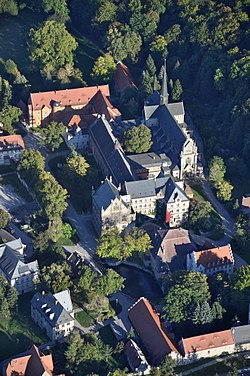Pforta monastery
| Kloster Pforta, sometimes Pforte |
|

Pforta seen from the air
|
|
| Monastery information | |
|---|---|
| Other names | Sancta Maria ad Portam (Sankt Marien zur Pforte) |
| Order | Cistercians |
| Established | 1137 |
| Disestablished | 1540 |
| Architecture | |
| Status | reused in school buildings |
| Style | Romanesque and Gothic |
| Site | |
| Location | Bad Kösen, Saxony-Anhalt |
| Coordinates | 51°12′56″N 11°45′18″E / 51.21556°N 11.75500°ECoordinates: 51°12′56″N 11°45′18″E / 51.21556°N 11.75500°E |
| Public access | yes (partial) |
The Pforta monastery is a former Cistercian monastery located near Naumburg in Saxony-Anhalt, Germany. It was established in the 1130s and prospered in the Middle Ages. In the course of Reformation the monastery was disbanded in 1540. Today the buildings are used by the school Landesschule Pforta. The site is located on the tourist route Romanesque Road and has been nominated by Germany for inclusion in the UNESCO list of World Heritage Sites.
Bishop Udo I of Naumburg who belonged to the House of the Ludowingers, met the Cistercian abbot Bernard of Clairvaux for the first time at the Imperial Diet in Liège in March 1131. This meeting can be seen as of central significance for the propagation of the Cistercian order in the Empire. For Bishop Udo I, it provided both motivation and opportunity to arrange for a delegation of monks from the Walkenried Cistercian monastery to settle in a location in the vicinity of the bishop’s town of Naumburg in 1137/1138.
The monastery complex itself comprises the religious, as well as residential and functional buildings. The minster, the cloister and the abbot’s chapel as well as numerous functional buildings from the monastery time and the mill stream Kleine Saale, which flows through the monastery property. Pforta ranked among the wealthiest and most influential monasteries throughout Central Germany before it was closed in the course of the Reformation. Today, the premises host a public boarding school run by the state of Saxony-Anhalt.
The richly ornamented western façade of the minster differs from façade designs of other Cistercian churches from the 13th century since it displays sculptural designs that did not correspond to the strict stipulations of the order. It is reminiscent of a Roman triumphal arch portal. This elaborately designed facade with its sculptural decoration symbolically expressed the meaning of the latinised monastery name of Porta, meaning Porta Coeli – i.e. "Pearly Gates" – through its architecture. It has been described as the ″most brilliant example of a towerless façade in Germany″.
...
Wikipedia

